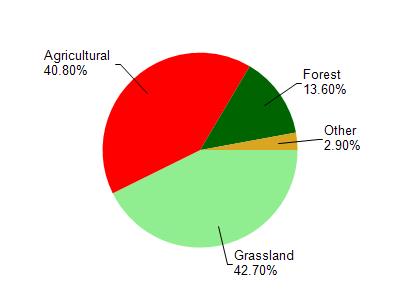Grant
Yes
No
No
Fish and Aquatic Life
Overview
Day Branch is a small spring-fed tributary to the Grant River near Lancaster. The stream is listed as a class II trout stream and is managed as a trout fishery although it is not identified as trout waters in the 2000 “Wisconsin Trout Fishing Regulations and Guide” (WDNR, 1980). Day Branch had a good brown trout fishery 25-30 years ago, however, degradation of instream habitat due to agricultural non-point sources of pollution has reduced the fisheries potential (Fix, 1991). The stream should be assessed to determine current conditions. Public access to the stream is lacking.
Date 2001
Author Aquatic Biologist
Historical Description
From: Smith, Tom D., and Ball, Joseph R., Lake and Stream Classification Project. Surface Water Resources of Grant County, Department of Natural Resources, 1972. Surface Area = .69 acre, Length = 1.9 miles, Gradient = 63 ft./mile, Flow = 2.1 c.f.s.
A moderate-gradient spring-fed stream entering the upper reaches of the Grant River from the east three miles west of Lancaster. This stream is known locally as "Days Branch". Strean bottom materials are primarily gravel and rubble which is reflected in the density of some of the aquatic bug-life production. Brown trout dominate the fishery and are stocked annually by the Lancaster Sportsman'a Club. Natural reproduction may occur because there are some suitable spawning areas in the stream. Brook trout are also present and the stream receives a large amount of fishing pressure from the local people. White suckers, creek chubs, and stonerollers make up the limited forage fish population. Game assets include a few muskrats and other upland species. The Grant River provides navigable water access. The stream can also be reached with permission though private lands and fence stiles are provided along Highway A by the Lancaster Sportsman's Club.
Date 1972
Author Surface Water Inventory Of Wisconsin
Condition
Wisconsin has over 84,000 miles of streams, 15,000 lakes and milllions of acres of wetlands. Assessing the condition of this vast amount of water is challenging. The state's water monitoring program uses a media-based, cross-program approach to analyze water condition. An updated monitoring strategy (2015-2020) is now available. Compliance with Clean Water Act fishable, swimmable standards are located in the Executive Summary of Water Condition in 2018. See also the 'monitoring and projects' tab.
Management Goals
Wisconsin's Water Quality Standards provide qualitative and quantitative goals for waters that are protective of Fishable, Swimmable conditions [Learn more]. Waters that do not meet water quality standards are considered impaired and restoration actions are planned and carried out until the water is once again fishable and swimmable
Management goals can include creation or implementation of a Total Maximum Daily Load analysis, a Nine Key Element Plan, or other restoration work, education and outreach and more. If specific recommendations exist for this water, they will be displayed below online.
Monitoring
Monitoring the condition of a river, stream, or lake includes gathering physical, chemical, biological, and habitat data. Comprehensive studies often gather all these parameters in great detail, while lighter assessment events will involve sampling physical, chemical and biological data such as macroinvertebrates. Aquatic macroinvertebrates and fish communities integrate watershed or catchment condition, providing great insight into overall ecosystem health. Chemical and habitat parameters tell researchers more about human induced problems including contaminated runoff, point source dischargers, or habitat issues that foster or limit the potential of aquatic communities to thrive in a given area. Wisconsin's Water Monitoring Strategy was recenty updated.
Grants and Management Projects
Monitoring Projects
| WBIC | Official Waterbody Name | Station ID | Station Name | Earliest Fieldwork Date | Latest Fieldwork Date | View Station | View Data |
|---|
| 964000 | Day Br | 10059413 | Day Branch 1.1 km US from confluence with Grant River | | | Map | Data |
| 964000 | Day Br | 10051962 | Day Branch_upstream of confluence with Grant River | | | Map | Data |
|

Watershed Characteristics
Day Br is located in the Upper Grant River watershed which is 106.09 mi². Land use in the watershed is primarily grassland (42.70%), agricultural (40.80%) and a mix of forest (13.60%) and other uses (2.90%). This watershed has 260.94 stream miles, 7.24 lake acres and 6.79 wetland acres.
Nonpoint Source Characteristics
This watershed is ranked High for runoff impacts on streams, Not Available for runoff impacts on lakes and High for runoff impacts on groundwater and therefore has an overall rank of High. This value can be used in ranking the watershed or individual waterbodies for grant funding under state and county programs.However, all waters are affected by diffuse pollutant sources regardless of initial water quality. Applications for specific runoff projects under state or county grant programs may be pursued. For more information, go to surface water program grants.